Teknisk leveranse
Her finner du informasjon for teknisk leveranse.

Alle leveranser til TV 2 skal produseres i henhold til TV 2s tekniske spesifikasjoner og retningslinjer for merking.
Teknisk filleveranse
Navn på leveranse-fil opprettes automatisk i TV 2s mottakssystem. Det vil bli gitt informasjon om leveringsfilnavn av prosjekteier i TV 2. Det er også mulig å få dette fra Content Service. Siden programmer lastes inn automatisk i TV 2s avviklingssystem, er det viktig at filnavnet er korrekt og at det samsvarer med tekstplakat og programinnhold.
Alle programmer skal ha en tekstplakat i starten med følgende informasjon:
- Tittel på programmet, sesong- og episodenummer
- Leveringsfilnavn
- Programmets start-tidskode (programstart)
- Tidskoder for delingspunkt
- Lengde på filen (inkludert tekstplakat og svarte hull)
Eksempel:
Tittel: Et perfekt program (1) episode 1
Leveringsfilnavn: G010101
Programstart: 00:00:10:00
Deling: 00:11:10:00 – 00:11:10:00
Deling: 00:22:10:00 – 00:22:10:00
Deling: 00:32:10:00 – 00:32:10:00
Lengde på filen: 00:44:11:04
Dersom programmet/innslaget inneholder produktplassering, skal dette merkes med Medietilsynets anbefalte merke, i tråd med Medietilsynets retningslinjer.
Produktplasseringsmerking skal være tydelig i venstre hjørnet og normalt vare i 6 sekunder.
Merkingen skal gjøres ved programmets start, slutt og etter reklameavbrudd. Nedlastbar fil finnes her.
TV 2 tekster alle norske programmer og administrerer dette via vår for tiden teksteleverandør Screen Media AS.
Produksjonsselskapet skal tilrettelegge for teksting og leverer tekstegrunnlag som manus, dialoglister/script der det er avtalt eller tilgjengelig. Manus/dialoglister, samt informasjon om eventuelle innslag av fremmedspråk sendes til ISPA-ContentService@tv2.no så snart dette foreligger.
Timesprogram skal ha lengde på minimum 42 minutter og maksimum 44 minutter. Programmet skal ha 3 delingspunkter, slik at hver del har omtrentlig lik lengde (4 x 11 min).
Halvtimesprogram skal ha lengde på minimum 20 minutter og maksimum 22 minutter. Programmet skal ha 1 delingspunkt ca. midt i programmet (2 x 11 min).
Programmer med lengde på 66 minutter skal fortrinnsvis leveres som 2 filer med hvert sitt leveringsfilnavn. Med mindre annet avtales med prosjekteier, skal del 1 være 44 minuter og del 2 skal være 22 minutter.
Programmer med lengde på 88 minutter skal fortrinnsvis leveres som 2 filer på hver 44 minutter, ed hvert sitt filleveringsnavn.
Alle deler/leveringsfilnavn skal ha delingstidspunkt som timesprogram/halvtimesprogram, forklart ovenfor.
Korte programmer på 10-15 minutters varighet skal ha et delingspunkt ca. midt i programmet.
Tidskoden på filen skal starte på 00:00:00:00.
Tidskoden på programstart skal starte på 00:00:10:00, for å ta høyde for en tekstplakat på 5 sekunder.
Rulletekst skal utformes slik at den oppfyller ufravikelige lov- eller avtalebestemmelser. (Se åndsverklovens § 5 1. ledd, §16 siste ledd og § 23 4. ledd). Rulleteksten skal være uten tale/handling, slik at programpresentatør kan snakke over rulleteksten.
Rulleteksten skal, dersom ikke annet er avtalt, være maksimum 16 sekunder lang.
Tidspunkt for levering er avtalt i Produksjonsavtalen/Visningsavtalen. Forsinkelser eller andre endringer skal informeres Content Services så snart som mulig.
Programmer med opptak samme uke som publisering, har egne leveringstidspunkt avtalt i forkant og i overensstemmelse med TV 2s prosjekteier.
Produksjonsselskapets leveranseansvarlige skal holde løpende kontakt med Content Service for detaljer og avklaringer, telefon: 55 90 80 75.
Levering «samme dag»
Program skal være ferdig lastet opp senest 6 timer før publiseringstidspunktet.
Dersom det er avtalt levering senere enn 6 timer før publisering, må ansvarlig hos Produksjonsselskapet være forberedt på direkte-avvikling av programmet inntil TV 2 har bekreftet mottaket som ok.
TV 2 kan ikke garantere at det vil bli gjennomført teknisk kvalitetskontroll av programmet før publisering.
Ved levering, send epost til ISPA-ContentService@tv2.no med følgende informasjon:
- Tittel på programmet, sesong og episodenummer
- Leveringsfilnavn
- Behov for teksting utover norsk språk
- Navn, telefonnummer og epostadresse til kontaktperson
Re-levering
TV 2 ønsker ikke å motta samme program mer enn 1 gang, og tar kun imot re-levering av programmer med sendekritiske feil etter en redaksjonell eller tekniske begrunnelse fra prosjekteier. Det må med andre ord avklares mellom prosjekteier og Content Service før produksjonsselskapet kan levere på nytt.
Tekniske spesifikasjoner for programmer
Finnes kun på engelsk.
HD Programmes commissioned on file must be delivered on:
XDCamHD 422 wrapped in MXF OP1a.
File based delivery is TV 2 AS’ preferred way of receiving material.
Video format and wrapper HD master files:
- XDCam HD 4:2:2 long GOP @ 50 Mbps wrapped in MXF OP1a (Sony)
- MXF Timecode according to AS-11 using the material package TC.
- GOP Structure being N = 3, M = 12. First GOP must be closed.
- Aspect ratio 16:9
- Resolution 1920x1080
- Standard / Frame rate PAL/25 (Interlaced, interlaced upper field first)
- Bit rate 50 Mbps
- Audio tracks 1-2 stereo
- Audio tracks 3-8 discrete 5.1 audio if available. If not available, tracks 3-8 shall be silent.
High definition programmes must be acquired, post produced and delivered in high definition. Programmes must contain a minimum of 75% native high definition material. Up to 25% of the programme’s duration can come from standard definition sources. Standard definition sources are defined as:
- All standard definition video formats
- Cameras with image sensors under ½”
- Frame based (intra-frame) recording formats below 100Mbs
- Inter-frame based recording formats below 50Mbs
- Super16 film whether transferred to tape in high definition or not
- 35mm film transferred to or copied from standard definition tape formats
- Non-linear editing codecs with bit rates below 120Mbs
- Live contributions links of less than 140Mbs (MPEG2)
High definition programmes should in general be clean of noise, well-lit and sharp (unless artistic considerations require otherwise).
Particular care should be taken up-converting standard definition material to include in high definition programmes. Only high quality up-conversion equipment should be used. Use of “in VTR” up converters or up conversion using non-linear editing software is not acceptable.
This requirement protects the standard definition viewer who will see the standard definition material after multiple conversions.
When stereo sequences are included in surround programmes, it is acceptable to “up-mix” the audio. Any audio treated this way must down-mix without any noticeable degradation and must be fully stereo and mono compatible. It is not permissible to up-mix entire programmes.
Multi-channel (5.1) timing on tape: The Multichannel audio signal should be in sync with the stereo signal ON TAPE. This positioning allows further processing to be done to the final tape if required.
Video format and wrapper SD master files (the delivery of a master file in SD format, must be agreed upon during purchase):
- IMX 50 Mbps I frame only wrapped in MXF OP1a
- MXF Timecode according to AS-11 using the material package TC.
- Aspect ratio 16:9
- Resolution 720x576 Anamorphic
- Standard / Frame rate PAL/25 (Interlaced, interlaced upper field first)
- Bit rate 50 Mbps
- Audio tracks 1-4 stereo (24 bit)
- Audio tracks 5-8 empty (24 bit)
TV 2 AS will accept high definition programmes acquired using
1920 x 1080 interlace at 25 frames a second (now called 1080i25), upper field first.
- All delivered high definition master tapes must be 1080i25 (whether the programme was acquired using 1080p25 or 1080i25). Rollers, moving captions and DVE moves must be added in 1080i25 to prevent unacceptable judder.
- Technical standards are fully detailed in the following documents;
- EBU Tech 3299-E (Systems 2) “High Definition (HD) Image Formats for Television Production.”
- SMPTE S274-2008 “Television - 1920 x 1080 Image Sample Structure, Digital Representation and Digital Timing Reference Sequences for Multiple Picture Rates” (Revision of SMPTE 274M- 2005).
- ITU-R BT.709-5 “Parameter values for the HDTV standards for production and international programme exchange.”
- EBU R128 “Loudness Normalisation and Permitted Maximum Level of Audio Signals.”
Graphics and action shall be within the safe areas specified for delivery to be sure that the items are readable. “Safe Area” is defined as 95% of the picture height and width.
Audio Standards
Programmes shall be delivered in Mono or Stereo Format as required.
- Left audio shall be present on Channel 1.
- Right audio shall be present on Channel 2.
Mono shall be in Dual Mono format with identical and coherent audio on both Left and Right channels.
Audio codec is PCM uncompressed. Sampling frequency is 48 KHz @ 24 bit for HD.
Sample frequency is 48 KHz @ 24 bit for SD.
Audio Level, Reference Level and Measurement
TV 2 has committed to the use Loudness (EBU R128). All programs must be compliant with the loudness parameters listed in this chapter.
Sound must be recorded with appropriately placed microphones, giving minimum background noise and without peak distortion. The audio must be free of spurious signals such as clicks, noise, hum and any analogue distortion. The audio must be reasonably continuous and smoothly mixed and edited. Audio levels must be appropriate to the scene portrayed and dynamic range must not be excessive. They must be suitable for the whole range of domestic listening situations. Stereo audio must be appropriately balanced and free from phase differences, which cause audible cancellation in mono. The audio must not show dynamic and/or frequency response artefacts because of the action of noise reduction or low bit rate-coding systems.
R128 introduces new terms for the measurements of audio. The terms used in this document, how they are measured and the delivery requirements are listed below. All programs must be compliant with the Program Loudness and Maximum True Peak requirements below. Other parameters are currently given for guidance only.
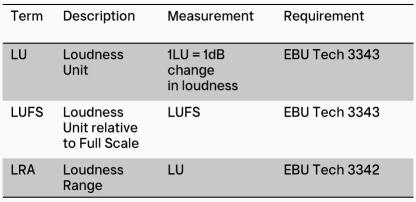
Delivery Requirements
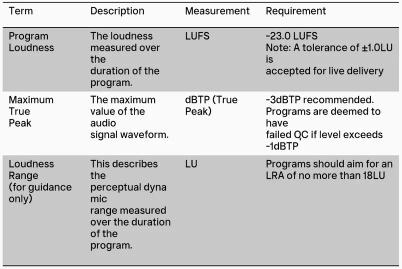
Although the target loudness is -23 LUFS, in exceptional circumstances other target levels may be permitted by agreement with the broadcaster. Other target levels must be agreed with the broadcaster before the final mix.
Delivery Requirements, Short-Form Content (advertisements, promos etc.)
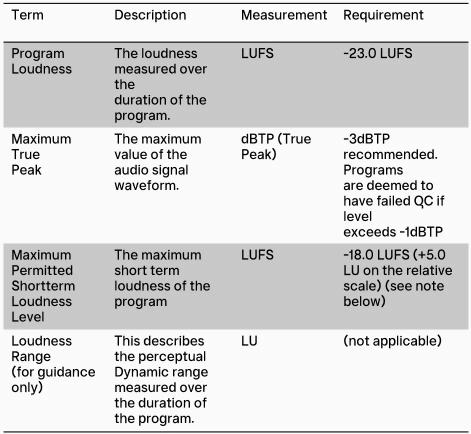
Note: Short-Form Content is defined as a program of short duration, typically shorter than 30s (but up too approximately 2 minutes’ duration). In addition to advertisements (commercials) and promotional items, interstitials, stingers, bumpers and similar very short items belong to this category.
Guidelines for True Peak audio levels
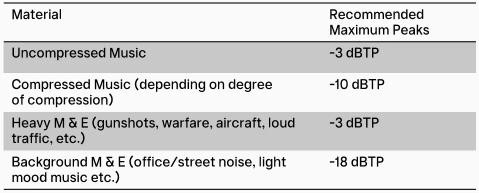
Meters must comply with the specifications in EBU Tech 3341. Programs must be measured using the EBU Integrated (I) mode and the measurement must be applied to the whole program.
Stereo tracks must carry sound in the A/B (Left/Right) form. If mono originated sound is used, it must be recorded as dual mono, so that it may be handled exactly as stereo. It must meet all the stereo standards regarding levels, balance and phase.
- Tracks 1&2 - Stereo main audio Left (A1) and Right (A2) – labelled as “Audio”.
- Tracks 3-8 - Empty – labelled as “Audio”.
Stereo line-up tones
Each stereo audio pair must have either EBU stereo or GLITS line-up tone (not a mix of both). Tone must be 1 kHz, sinusoidal, free of distortion and phase coherent between channels. Line-up tones are only relevant for the delivery of live programmes. Audio files of GLITS and EBU stereo tones may be downloaded from the DPP web site (see 4.7). Digital Audio Reference level is defined as 18dB below the maximum coding value (-18dBFS).
Each stereo audio pair must have either EBU stereo or GLITS line-up tone (not a mix of both). Tone must be 1 kHz, sinusoidal, free of distortion and phase coherent between channels. Line-up tones are only relevant for the delivery of live programmes. Audio files of GLITS and EBU stereo tones may be downloaded from the DPP web site (see 4.7). Digital Audio Reference level is defined as 18dB below the maximum coding value (-18dBFS).
Stereo program audio must be capable of mixing down to mono without causing any noticeable phase cancellation.
Surround sound is transmitted in the 5.1 format, and should normally be delivered as discrete tracks, except by agreement with the broadcaster. Programs delivering surround sound must also carry a stereo mix meeting all requirements for stereo delivery. This should generally be an automated down-mix of the surround channels, using the same down-mix parameters as are held in the surround metadata. In order for both the surround mix and stereo down-mix to comply with EBU R128, the down mix should be normalized before layback (for file or tape delivered programs). Stereo and surround audio tracks must be synchronous.
Programs delivered with multichannel audio, must have the following track layout:
- Tracks 1&2 - Stereo main audio Left (A1) and Right (A2) – labelled as “Audio”.
- Tracks 3&8 – Surround sound – labelled as “Audio”.
Dolby Track Audio Track
3 Front Left
4 Front Right
5 Centre
6 LFE
7 Surround Left
8 Surround Right
This section refers to timing requirements for AES audio pairs embedded in HD SDI signals. Very small timing differences between audio tracks in a surround program will not be heard unless the stereo down-mix is monitored acoustically. An error of as little as one or two samples between the Left, Right and Centre channels can cause phasing and comb filtering for those listening in stereo. Timing differences between audio tracks in each AES pair in an SDI group and between each group containing a single audio program must be no more than 0.2 samples (i.e. the timing between each track of the six audio tracks of a surround signal.)
Note: This error has not been noticed on devices that treat audio as multi mono channel audio (e.g. NLEs).
The relative timing of sound to vision should not exhibit any perceptible error. Sound must not lead or lag the vision by more than 5ms.
To assist in maintaining A/V sync through the post-production process, a ‘sync plop’ may be used. If the delivered program leader contains one, it must meet the following conditions:
- The sync plop must be between timecode xx:xx:57:06 and xx:xx:57:08
- The audio plop must be 1kHz tone on all tracks at -24dBFS (-18dBFS is
acceptable for stereo programs)
- The duration of the vision flash must be 2 frames to allow it to pass through
standards conversion successfully
- The audio plop must be synchronous across all audio PCM audio tracks and with the video flash (within +/- 5 ms)
If an end sync plop is used it must be no closer than 10 seconds to the end of the program and comply with the relevant points above.
A zip file of acceptable line up tones can be downloaded from the DPP website:
http://www.digitalproductionpartnership.co.uk/downloads/standards/
It contains:
Surround Programs - BLITS -18dBfs
Stereo Programs - EBU 1 kHz>
Programme Types
Programmes in this section fall into the following categories:
1. Live programmes from within TV 2 buildings with a fixed and permanent connection to TV 2 AS
2. Live programmes with links provided by third parties (e.g. satellite, fibre, microwave etc.).
Usually high definition programmes should only deliver a high definition signal.
Technical parameters for the incoming signal
Signals from remote sources may pass through several different agencies (suppliers) therefore it is vital that:
- sufficient monitoring is in place at all interfaces to ensure continuity of signal quality.
- there is agreement over the share of responsibility for each element in the chain(s).
- all parties are able to monitor and assess the signals arriving and departing from their domain(s) of responsibility.
- audio and video are in sync arriving and departing from each area of responsibility.
The incoming signal must be able to be passed through the play-out and transmission chain without the need for manual intervention.
Unless agreed in advance all programmes must supply a high definition signal that meets the requirements of the ITU-R BT709-5 1920 x 1080 25-frame standard with synchronous embedded audio:
- Stereo audio will be embedded on audio tracks 1+2.
- Surround sound (when supplied) will be Dolby E encoded and embedded on audio track 3+4.
- If Dolby E is supplied, it should be on track 3+4, and should be continuous from -30 seconds (30 seconds before the start of the programme) until 10 seconds after the end of the programme.
The remote facility must be able to originate vision and audio line-up signals, including aspect ratio information and identifying the left and right audio channels and if required, the individual channels for a multi-channel or surround sound programme. Care should be taken to ensure that pre-recorded inserts are in the same aspect ratio and resolution as live material.
Required checks will include representative moving pictures and synchronous sound.
Line-up signals must be available at least 30 minutes prior to the programme start time, and a technically competent contact must be designated to liaise with the broadcaster’s engineering staff.
The video and audio signals must be continuous and stable in all respects throughout the broadcast period. Remote sources to the facility must be fed in such a way to ensure stable synchronous signals are present on the transmission output at all times.
The digital signal characteristics must meet with EBU/SMPTE Recommendation 701.
High Definition Contribution Links
Programmes from studios in the TV 2 Network must be transferred with a minimum of 140Mb/s.
To maintain the quality of the high definition signal, a link with an appropriately high bit rate should be used. For the best possible quality an uncompressed link is always the best option however where this is not viable it is recommended links should be at least 60Mbs MPEG 2 for a single “hop” link.
To allow further processing (recording, editing etc.) especially if the signal is then sent by additional contribution links, the highest bit rate possible should be used. It is preferable that links in this case be at least 100Mbs MPEG2
Standards conversion from remote source
When a programme is supplied via a contribution link of less than 100Mbs, the standards conversion must be done on site before the contribution link.
Subtitle files shall be delivered in the. stl format. Framerate set to 25 fps.
Naming convention for the delivered file is <filename HR file>-opn.stl for OPN files and <filename HR file>-ttv.stl for TTV files. All subtitle files must contain 0-Text with the following parameters:
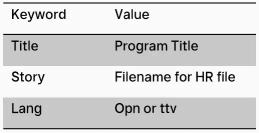
TV 2 want to make use of PAR/DAR information from the MXF header if possible. TV 2 are currently looking into the AMWA AS-11 X3 file exchange standard. Although we recognize the difficulties adopting our historical archive into this standard, we will remain open regarding adopting this standard for future deliveries.